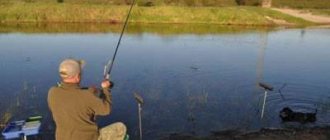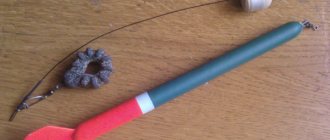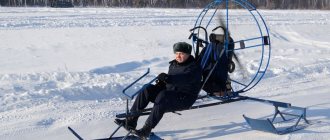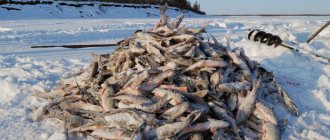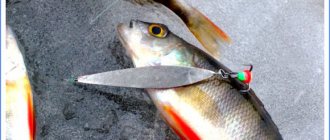What did you drive in the 20th century?
For example, the so-called motorized dogs. Have you ever heard such a strange name? This is a means of small-scale mechanization, invented in the 70s of the last century and which replaced the traditional dog sled. Motorized dogs were called sleds with a steering wheel, which were equipped with a small motor.
They were otherwise called motorized towing vehicles. The design of the first models was quite primitive, weight - from 40 to 65 kilos, but this was already a real breakthrough in technical terms. Subsequently, the device was modernized, and nowadays no hunter or avid tourist would refuse to purchase a convenient and modern motorized towing vehicle.
Further more. Over time, humanity invented and patented homemade means of transportation in the snow in huge quantities. Sometimes these are very original and even exotic devices. We are talking not only about classic snowmobiles, but also about snow motorcycles, snow bikes and even snow tanks. Many names are still a wonder to mere mortals.
Reliable transport for a trip to nature in winter
As you know, you want to have a good time outdoors not only in the summer heat, but also in the cold season. In winter, hunters, fishermen and other lovers of outdoor activities with snowmobiles, motorized towing vehicles, home-made or factory-made all-terrain vehicles are not afraid of either light frosts or huge snowdrifts. With reliable transportation, you can navigate your way through almost any conditions. Let’s talk today about these “miracles of technology”, let’s briefly understand how they work, and talk about their advantages and disadvantages.
Snowmobiles
These “iron horses” can have a two-stroke or four-stroke engine. In the first case, the cost of a snowmobile is usually less. This motor is quite powerful, but very noisy and not very economical. It consumes not only a lot of gasoline, but also oil.
In addition, when a two-stroke engine operates, a large amount of exhaust gases are released. In developed countries, environmental activists are seeking a ban on the operation of such equipment.
Four-stroke engines are larger and heavier than two-stroke engines, and accordingly the weight of the snowmobile is higher, sometimes even by 50%. From the outside it may look as if you are constantly carrying one extra passenger. In loose snowdrifts, winter transport goes worse, fails, and maneuverability decreases.
The advantages of four-stroke engines include their efficiency and environmental friendliness. They do not need to fill the fuel tank with a mixture of gasoline and oil. Such engines operate less noisily and have an increased service life. They may require maintenance after an average of 10-12 thousand kilometers, provided that they are used carefully, in compliance with all standards, and using high-quality engine oil.
For two-stroke engines, problems cannot be ruled out after 6000-8000 km. If you regularly test the “iron horse” for strength and “feed” it with cheap fuel, then malfunctions may appear even after three thousand kilometers.
It is clear that these are averaged data, which are also very relative. For example, a snowmobile with a two-stroke engine for an attentive and thrifty owner will sometimes last longer than for a carefree extreme sports enthusiast who bought more expensive equipment with tracks and skis.
"Motordogs"
A tow truck is one of the cheapest means of transportation on snow and ice. It is very economical; on average, the engine consumes no more than three liters of fuel per hour of travel. Spare parts and consumables also cost pennies. At the same time, “motorized dogs” are distinguished by good maneuverability, although they cannot develop high speed.
There are various options for towing vehicles with different types of suspension. For example, a slippery one allows you to perfectly overcome loose snowdrifts of various steepnesses. At the same time, driving on an icy, flat road will not be very convenient. Strong vibration may be felt while moving. Significant heating of the slides cannot be ruled out, which can lead to premature wear of the elements.
The roller suspension promotes comfortable movement both on snow and ice. However, it is advisable to avoid large and loose snowdrifts on the way. While overcoming them, cross-country ability may sharply decrease as snow gets inside the tracks.
It is very easy to drive “motorized dogs”; in addition, they are often equipped with an automatic transmission. Another advantage is the low weight of the equipment and “compact dimensions”: the dimensions in the transport position usually do not exceed one and a half meters.
If you plan to mostly move on flat and smooth ice, then choose a towing vehicle with an engine power of six and a half horsepower. Such a unit can easily transport a couple of people and some cargo. If you usually overcome deep snowdrifts and carry a sled with a heavy load, then you need an engine with at least 10 horsepower.
Western exotic
For example, skibobs. What it is? By its type, it is a means of transportation in the snow, reminiscent of a bicycle, which has skis instead of wheels. As in a regular bicycle, the driving force is human muscles. Turns are made using a pair of short skis attached to the boots.
There is a special tank for moving through the snow. The heavy unit (almost 4 tons), powered by diesel, was originally designed for military purposes. Now anyone who has free cash of at least 270 thousand euros can buy it.
In the West, another unit has also been developed, on caterpillar tracks, the electric motor of which transmits torque to each of the four tracked axles. The triangular tracks are so reliable when traveling through deep snow that getting stuck is only possible if the battery is completely discharged.
There are snow motorcycles (in front there is a ski, in the back there is a caterpillar drive). Such riders reach speeds of at least 100 km/h on slopes. There are also propeller-driven machines - units of the future intended for space development.
Modern snowmobiles have glass cabins and powerful electric motors. The most “advanced” models are not easy to find in mass production - for now they are rather exclusive. Among the simpler options, it is worth mentioning snowmobiles, equipped with a propeller and capable, despite their rather ordinary appearance, of developing a decent speed - about 120 km/h.
Basic rules for moving on snow and firn
On a snowy or firn slope, you can create a foothold almost anywhere. Depending on the structure, density, and condition of the snow, the technique of movement also changes. It may vary from meter to meter. And the choice of technical method of movement and overcoming any snow slope primarily depends on the condition of the snow. To move through snow and firn, you need to choose the easiest path, even if not the shortest. First of all, the ascent path must be safe.
The main efforts when moving on snow and firn are spent on trampling the trail and knocking out steps. You should never go all out; it is better to change the leader in the group more often than to work until exhaustion.
How to trample the steps? In fresh soft snow, the foot is placed so that the steps are inclined into the slope and the entire sole fits on them. You should not sharply kick into the snow; it is better to gradually compact the footprint in it. When knocking out steps on the rise, there should be no large steps - after all, the smallest person in the group will follow these steps. The distance between the steps should be such that when the upper, next step is trampled down, the lower one does not collapse. If the trail creeps away (for example, on a steep slope a layer of loose snow lies on the surface of ice or firn), you must first trample down the step on the slope somewhat, and then, throwing snow on the sides, trample it down. The support is gradually compressed. You must avoid kicking hard in the snow. This helps preserve steps that can collapse from a sharp blow, saves the climber’s strength, and reduces the risk of an avalanche (Fig. 4)
Very deep, freshly fallen snow often requires additional knee work when making tracks. First, the snow is trampled down by the boot; as soon as the foot is completely immersed in it, you need to simultaneously lean on the snow - this way the body weight is better distributed on the surface of the slope and the boot falls through less.
Moving in the snow has its tricks. When moving on fragile crust, there is no need to try to stay on its surface. It is better to break the crust with a sharp blow, and then press the sole to compact the step underneath it - this way it is easier to maintain balance and save energy. The body weight must be smoothly transferred from step to step, resting on the entire foot. Sometimes you can hold on on a steep crusty slope by resting the middle of your sole on the edge of a step cut into the crust, and your shin on the crust, thus distributing your body weight over a large surface area of the snow (Fig. 3) . This is how you should move on the crust.
On hard firn, depending on the density of the snow and the steepness of the slope, steps are knocked out with the toe of the boot or the welt of the soles. The steps should be inclined inwards into the slope as much as possible and be of such a size that they can accommodate most of the sole. The step can also be straightened with an ice pick.
When moving on snow, firn crust, it is necessary to maintain a vertical body position, especially if the steps are unreliable (loose snow, smooth sublayer on which compacted steps slide down). If the body is not vertical, the risk of slipping increases.
When moving in deep snow, ski poles are a great help.
Descent on firn or snow of low or medium steepness is carried out with your back to the slope. The steps are knocked out with the heel so that they are inclined inward of the slope.
The basic rule when descending steep sections is that as soon as you start to feel unsure with your back to the slope, immediately turn to face it. When moving facing the slope, the steps are knocked out with the toe of the boot. They simultaneously serve as good supports for the hands.
Planing on the soles of boots is allowed only where the slope is not too steep, and the snow is hard and ends with a safe rollout, and there are no cracks or stones in the way. The speed of descent is regulated by digging your heels into the snow and turning, as well as braking with an ice ax.
On gentle slopes (25-30°), moving through snow and firn, it is best to climb straight up. The feet are placed parallel if the snow is sufficiently loose, deep, and soft. The steps are compacted until a snow cushion is formed, on which the foot is then placed. Those walking behind, if necessary, improve the trampled tracks by pouring snow with their feet into the prepared recesses and tamping. Ice ax on a lanyard. It is held by the middle of the handle, head back, beak down, or used as a support (Fig. 5) . If the slope is steep enough to cause a fall, the ice ax is kept in the “ready” position. It is much easier to lean on an ice ax when your foot slips at the first moment than to engage in self-restraint in the event of a fall. The legs are placed on the same line.
With an increase in the steepness of the slope and the hardness of the snow, they switch to a zigzag, changing the direction of movement from time to time (Fig. 6) . It is recommended to move on firn and snow at an angle of 45° to the line of falling water - the most economical way. If the steepness is not very great and the snow holds well, you can climb at an angle of 70°. This saves time. The ice ax is taken in both hands in the “ready” position, the bayonet should always point towards the slope (Fig. 7) . As the steepness of the slope and the depth of the snow increase, the ice ax can be used for support, driving it into the snow with every step or pair of steps.
To climb through dense snow you need to use micro-relief. The steps are knocked out by the welt of the boot with one or several oblique sliding blows. At this moment, for a more secure position, you need to lean on an ice ax. All this requires some skill and practice, as you can lose your balance. The following operating procedure is recommended. First, the ice ax is stuck with the bayonet down into the snow at waist level. Then the welt of the boot of the foot, which is closer to the slope, knocks out a horizontal step. The leg span is small, due to the shin, and does not interfere with the climber’s stability. Next, stand on the step with your foot and transfer your body weight to it. At the same time, lean on the ice ax with both hands. The movements are smooth, the body position is vertical. The next step is knocked out with the inner welt of the leg standing lower on the slope.
On moderately steep slopes (25-30°), the ice ax is moved to a new fulcrum with each step. On steep slopes (40-60°), two steps are taken per cycle of ice ax operation.
The rotation at the zigzag corner is performed in the following order: from the position shown in Fig. 8 , you need to lean the pin of the ice ax into the slope, then (if the slope is on the right), standing on your right foot, knock out the step in front, above the supporting leg, with the toe of the boot of your left foot; then, turning to face the slope, move your right leg forward and, using the welt, knock out the next step in the opposite direction of the zigzag. After this, without lifting the ice ax blade from the slope, grab the handle and head of the ice ax with your hands. The ice ax is now pointing with the bayonet towards the slope on the left.
If the slope is 50-65° steep, you need to climb head-on in three steps, turning to face the slope, constantly having two points of support. Holding the ice ax by the head, standing on both legs, the climber sticks the ice ax into the slope along the entire length of the handle (first step). If this fails the first time, the operation is repeated. The hole formed in the snow (firn) can be expanded by turning the ice ax by the head. Then, standing on one, for example, left leg and holding the head of the ice ax with both hands, use your right toe to knock out a step at the level of your left knee, place your right leg on it, straighten your leg at the knee (second step). Next, standing on the right foot and holding the head of the ice axe, knock out the second step with the toe of the left foot and place the left foot on it (third step) (Fig. 11) .
Similarly, a steep slope is traversed in three steps. The slope is traversed by standing facing it, as shown in Fig. 9 . With a traverse, there are always two points of support. With their legs spread wide apart, they stick an ice ax in front of them, then, holding onto it, with the toe of the boot of their left foot they knock out a step next to their right foot, and the climber stands on it. Then they knock out the step with their right foot, etc. For a more stable position, you can sink your hand into the snow and hold on with an ice ax and your hand (Fig. 10) .
Traversing non-steep slopes is carried out in a position sideways to the slope by laying tracks along two parallel lines (the upper one is for the leg closest to the slope). This arrangement increases the climber's stability. The step is knocked out with the welt of the boot at a distance of an average step. The ice ax is held in the “ready” position or the climber leans on it. On steep slopes with soft snow, you should move as you would on hard snow. Maintain smooth movements so as not to tear off the steps. If the snow is sticky and sticks to the soles, it must be knocked off with an ice ax on the boot welt.
Loose snow on a smooth icy base is unreliable. Here you need to use the property of snow to freeze when compacted. With a light blow, the leg bent at the knee is immersed in the snow until the toe touches the ice. Then, without lifting the toe, press the horizontal step with several vertical light pressures of the heel.
If the firn or ice sublayer does not hold the steps well, sliding under load, double pressing of the steps is used. With a light kick of the foot, the snow is pressed perpendicular to the slope, which creates a kind of foundation that freezes to the sublayer. Then, using snow from the sides, a step is formed on the foundation, leveling its surface to a horizontal position. If the layer of loose or muddy snow is thin, it is better to use crampons.
Deep, loose snow under the fragile crust allows the formation of steps in its thickness. To do this, pieces of the crust broken by the foot are pressed together with the snow that has fallen from the edges of the footprint. A compressed lump formed in the depths of the snow mass with a relatively wide base, resting on the deep layers of snow, can support the weight of a person if the weight of the body is transferred slowly and smoothly, allowing the steps to freeze.
Frosty, sandy, recrystallized snow, as well as deep frost that sometimes forms under the crust, may not be able to be pressed, and the formation of steps in the depths of such a snow layer is often impossible. In this case, it is recommended to rest on the crust with the sole of the boot and shin (see Fig. 3) .
Very loose and deep snow on a steep slope is overcome by punching a trench, trampling steps at its bottom and organizing belay points. However, this requires great effort, destroys the integrity of the slope and increases the avalanche danger.
In loose snow, if you don’t hold the ice ax well, you can gain a foothold on the slope by running your second hand into the depths of the snow slope.
Movement along a sharp ridge of dense, wind-pressed snow is carried out on horseback or on one, flatter side, as when traversing a snow slope of appropriate steepness.
The cornice is walked along the opposite slope below the line of possible separation. Access to the ridge or descent from it is carried out only to the side of the cornice or a hole is punched through it.
When moving on a closed glacier, the probability of falling into a crevasse always remains.
You should walk with alternating belay, carefully probing the snow in front of you (Fig. 12) . If the ice ax enters the snow tightly, with force, without piercing it along the entire length of the handle, it means that a possible crack is tightly covered with snow. But you still need to walk carefully and carefully, gently placing your feet on the snow. If the snow bridge is unreliable, they crawl across it on all fours or on their bellies, supported by a flat-lying ice ax (Fig. 13) .
When descending the bridge, they slide down while sitting, feet first, with the ice ax in the “ready” position. Open narrow cracks are overcome by jumping, usually from a higher bank to a lower one (Fig. 14) .
In any case, increased attention and reliable insurance are required. The technique for descending snow slopes depends on the condition of the snow and the steepness of the slope. They go down a gentle slope while standing with their backs to the slope. If the possibility of falling is small, and the slope has a good gentle slope, you can walk using an ice ax as a support point (Fig. 15) . As the steepness of the slope increases, the ice ax is taken to the “ready” position (Fig. 16) , with the pin facing the slope. On loose snow you need to walk almost without bending your knees, driving in your heel and placing your foot at a right angle to your shin. The step should not be too long, since if you fall through, it is difficult to pull your foot out of the snow. In harder snow on the descent, the tracks are made with the heel. They go down the loose deep snow with large sliding steps, avoiding jumps with emphasis on their heels. It is better to walk on virgin soil, and not on the trail of the person ahead. On a steeper slope, where the slope is too low for planing or the snow is not slippery, they walk with the tip of an ice ax resting on the slope.
On smooth, non-avalanche-prone slopes without cracks and stones, with a steeper than average steepness, they descend by planing
(Fig. 17) .
The body weight is evenly distributed over both legs bent and slightly apart. The soles of the boots are placed parallel to the slope. Skier's stance. The pin of the ice ax rests on the slope, thereby regulating the speed of descent. Speed is also controlled by turns made by the boot welts, similar to alpine skiing. To stop, you need to put your feet sideways, perpendicular to the slope, and put more weight on the ice ax and heels. It is impossible to plan in tandem on an unfamiliar slope and slopes located above cracks, rocks, screes - it is dangerous. They descend a steep slope in three steps, standing in a position facing the slope. In this case, the rule of two points of support is observed. The technique is similar to the three-stroke lifting technique (see Fig. 11) .
The general rule is to take your time on descents. If you feel unsure, immediately turn your face to the slope and go down in the most reliable way - in three steps.
Universal equipment for moving on snow
At the beginning of the second half of the last century, much-needed vehicles in the harsh winter conditions began to appear in the vastness of the Russian North, which were called caracats. These are real homemade products for moving in the snow. Craftsmen simply equipped an ordinary motorcycle with powerful cameras designed for trucks.
The caracat overcame small water obstacles without any problems and did not get stuck in the fluffy snow. Later, such a snow and swamp vehicle was improved and turned into a modern high-tech vehicle, the production of which was undertaken by many domestic enterprises.
The design of any station wagon in this series is simple, reliable, and provides cross-country ability in any conditions and in any weather. The body frame is a metal structure made of durable pipes covered with steel sheets, waterproof and heated from the inside. The huge tires have ultra-low pressure, which is why they are not afraid of off-road conditions. This universal northern transport is available to fishermen and hunters and is completely environmentally friendly.
The best means of transportation in the snow
TOP 10 best vehicles for winter.
In many countries around the world, with the arrival of winter, the road situation becomes more difficult due to precipitation in the form of snow. Many of us don't like this time of year due to snowy roads, ice and increased fuel consumption.
Some motorists also stop using their cars in winter. But most of us drive in winter, experiencing various difficulties with snowy and icy roads in our own cars.
In this situation, owners of all-wheel drive crossovers and SUVs are in a more advantageous position. But still, these vehicles are not perfect for driving on snow.
There are many different means of transportation in the snow in the world. The domestic online publication has selected for you the best types of vehicles that are excellent for driving on snowy roads.
10) Tucker Sno-Cat
This is a kind of special car that is recommended for driving in the snow. This type of vehicle is excellent for traveling on snowy mountain slopes (for example, at ski resorts) or will be an indispensable assistant on an expedition to the mountains (winter).
Where cars on simple tires cannot go, this type of vehicle can take you anywhere.
9) Tatra Aeroluge
During World War II, by order of the German army, the Tatra T87 car was modernized for driving on snow. Instead of wheels, skis were installed on the car, and a propeller appeared in the rear.
Husky dog team
If a team of Husky dogs can travel the whole of Alaska in winter, then they will not have any trouble doing this anywhere in the world where a fierce winter rages. This is the most charming and unusual method of “defeating the snow.”
The most reliable form of winter transport in the world.
7) RaptorTRAX
If you replace the wheels with snow tracks, any 4x4 SUV will be able to easily move across any snow-covered fields and roads. This will be especially easy for the modified F-150 Raptor SUV.
Who said that harsh winters and snowy roads are a bad time of year?
6) Terra Bus
These all-terrain buses are used in Antarctica to transport people from the airport to the polar bases. You yourself realize that such equipment not only must withstand ultra-low temperatures, but must be prepared for strong winds and snow storms.
Thanks to its own design and huge wheels, the diameter of which is 1.87 meters.
5) Volvo BV202
The BV202 is ready to conquer virtually every snowy obstacle in its path. Thanks to the design that Volvo engineers came up with, this equipment is indispensable for expeditions and for traveling on the roads of the Far North.
The mechanical all-wheel drive and gearbox will not let you down in a difficult 60 seconds. Interestingly, the rear of the car may have been modified into an open-top body to turn it into a sailing vessel.
4) All-terrain vehicle Arktos
The all-terrain vehicle Arktos is capable of performing various tasks in extreme weather conditions. For example, it can extinguish fires and evacuate vehicles, both in the Sahara Desert and at the North Pole of Antarctica.
So, if there is a similar tow truck near you, then you have the opportunity not to fear that if you get stuck somewhere in an impassable place, no one will help you. This equipment can arrive or sail anywhere and in any weather conditions.
3) Lockheed LC-130
In a word, this is not an airplane, but a “rocket” that is not only super-powerful, but can also fly in a direction that more than one vehicle cannot reach on the ground. Thanks to the special design of the landing gear, the aircraft can land and take off from snow-covered soil.
2) Screw-propelled self-propelled vehicles
It goes without saying that you have never seen vehicles exactly like these under any circumstances. In addition, in the Far North, such equipment is unique, despite the fact that the design of the vehicle allows these tractors to move in arbitrary weather conditions on any roads.
In addition, if drifts on the roads are higher than 2-3 meters, these screw cars are capable of slowly but correctly making their way through terrible drifts.
1) M67 flamethrower tank
What's the best way to get around on a blocked road? It goes without saying that it is a tank, but not a simple one. For example, a tank that can shoot fire (flamethrower).
Such equipment is capable of not only paving a road through impassable snow drifts, but is capable of burning everything in its path.
NEW generation summer vehicles
Similar articles selected for you:
- The best cars for dangerous situations and disasters
- The best gifts for car enthusiasts
- The best New Year gifts for car lovers
- The best car toys for your kids
Let's talk about homemade structures
Perhaps the most interesting thing for the reader to know is whether it is possible to make a vehicle on snow with your own hands? After all, the cost of such equipment is not affordable for everyone, and there are many hunters-fishermen and just tourists among us Russians.
Well, having stocked up with the necessary tools, ingenuity and some time, it is quite possible to assemble such a unit yourself. The basis of the design will be the most ordinary walk-behind tractor. In summer, it can be detached from the snowmobile and returned to its place.
Snowmobiles come with either one ski or a pair of runners, and can have different engines (water or air cooling) and types of transmissions. They are economical and - due to their low weight - quickly overcome obstacles that are inaccessible to cars. In addition, high maneuverability and excellent movement on snow make them truly indispensable in the winter forest (for example, for hunters).
They are used in rescue work, fishing, and travel.
Motorcycles for fishing with riding in the snow - description
It is often used by fishermen and hunters in winter to move long distances on ice. Traveling by car is not only unsafe, but in some cases it is impossible due to the lack of access to the entrance.
Motorcycles resemble in appearance a combination of sleighs and skis with a motor. They are available with both automatic transmissions and CVT, which is more convenient and cheaper.
Design Features
The features include the mandatory components of such a vehicle, without which it will be impossible to move properly:
- The motor is what sets the device in motion. If you make it yourself, an engine from a moped will be suitable, which will be resistant to frost;
- The gas tank is where the liquid is poured. You can use a gas tank purchased in a store or from scrap materials. You should absolutely not use plastic containers that cannot withstand fuel.
- Wheels and skis are what motorbikes use to move around. You can use absolutely any wheel, but a car wheel is best;
- Skis should be stronger, so it is recommended to take mountain skis;
Note! You can add a caterpillar, of course, this option costs a lot of time, but these motorcycles will stay better on ice.
Dimensions and weight
Sizes may vary depending on the model range. The average assembled size is 1500x750x600 mm, in working condition 2700x650x750 mm.
The weight of the product itself also depends on the brand and power, for example from 65 kilograms to 120. The weight that can be transported is 20-40 kilograms.
Movement speed
The maximum travel speed in the minimum configuration is 20 - 25 kilometers per hour, and in the maximum configuration 70 - 80 kilometers per hour.
What do we need
To assemble a homemade snowmobile on tracks, we stock up on the following components - an engine, runners, tracks and a steering wheel. We choose a suitable drawing or sketch (or come up with our own). A necessary condition is the presence of two parts: a driving one (drive, frame, power unit) and a driven one (steering wheel, runners, shock absorber).
The frame is assembled from ordinary pipes of not very large diameter. You can also take a ready-made motorcycle frame. The desired shape is given by welding - first spot welding, then a continuous seam.
The motor-walk-behind tractor is connected to the tracks by a chain drive, which goes directly to the drive shaft. The simplicity of the design ensures lightness and excellent maneuverability, as well as stability and good traction force. The drive is assembled from a motorcycle chain, a pair of sprockets and a drive track shaft in the same way as a bicycle drive.
It is quite easy to make tracks, having a transport or regular rubberized tape with tracks (load bearings) - transverse slats made of plastic or tin, fixed evenly on the tape. They are secured with bolts. For large devices, the tape should be wide enough. It is advisable to make sled runners from metal or impact-resistant plastic.
Assembling our snowmobile
At the first stage, the frame structure is welded. Try to get by with the minimum required number of parts. Then we mount the engine - either under the seat or in front of it. The tracks and drive are being assembled. The drive shaft can be equipped with a reverse gearbox, which is not so difficult to find on sale. With its help it is easier to install the chain and you can increase traction.
Then we connect the frame and tracks. How to do this: the wheel axles are attached to the frame with bolts and couplings, and the front wheel is connected to the motor with a chain. Only after checking the functionality of the entire structure are the tracks tensioned and fixed on the wheels.
Now we have at our disposal an excellent means of transportation in the snow - a snowmobile made with our own hands!





